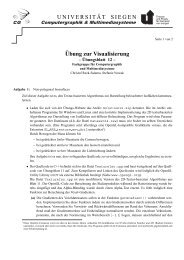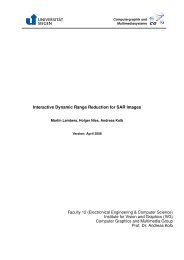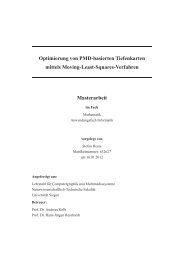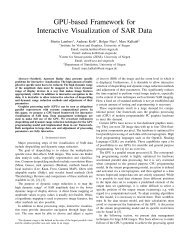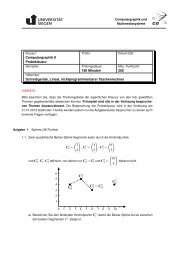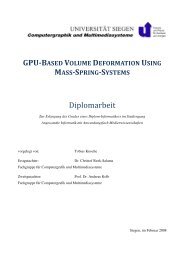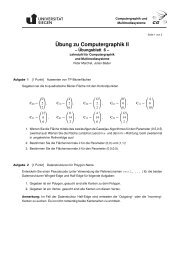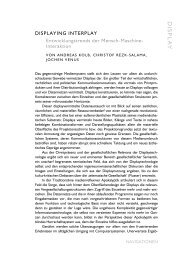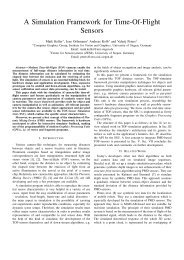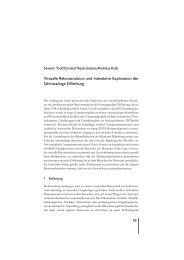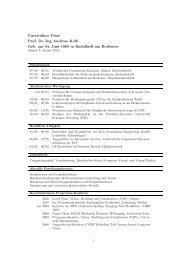Production-Ready GPU-Based Monte-Carlo Volume Rendering
Production-Ready GPU-Based Monte-Carlo Volume Rendering
Production-Ready GPU-Based Monte-Carlo Volume Rendering
Create successful ePaper yourself
Turn your PDF publications into a flip-book with our unique Google optimized e-Paper software.
TECHNICAL REPORT, COMPUTER GRAPHICS GROUP, UNIVERSITY OF SIEGEN, 2007<br />
which is derived from the Boltzmann equations. It describes the scattering<br />
events at a point x on a surface. L o is the outgoing radiance<br />
which leaves the surface in direction ω o . It is computed as the integral<br />
of the incoming radiance L i over the hemisphere Ω centered around<br />
the surface normal n. The incoming radiance is weighted by the bidirectional<br />
reflectance distribution function f r (BRDF) and the cosine<br />
of the angle of incidence cosθ i = (n · ω i ). Most surface rendering<br />
techniques assume light transport in a vacuum. In this case scattering<br />
events are taking place at object boundaries only.<br />
Inside of natural phenomena scattering events are considered to potentially<br />
happen at every point inside this participating medium. In this<br />
case, the BRDF f r is replaced by the phase function p, and incoming<br />
radiance is integrated over the entire sphere S 2 ,<br />
∫<br />
L o (x,ω o ) = p(x,ω o ← ω i )L i (x,ω i )dω i .<br />
S 2<br />
The phase function describes the scattering characteristics of the participating<br />
medium. The most popular phase function models are<br />
Henyey-Greenstein, Schlick, Mie and Rayleigh (see [10, 5, 21]). Note<br />
that the cosine term from Equation is omitted in Equation , since<br />
the phase function directly operates on radiance values rather than differential<br />
irradiance like the BRDF. For clarity, the optional emission<br />
term was also omitted in Equation .<br />
For semi-transparent surfaces, scattering events are still considered<br />
to happen only at surface boundaries, but light can be transmitted<br />
through transparent or translucent materials. The BRDF in Equation<br />
is supplemented by a bidirectional transmittance distribution<br />
function (BTDF) f t defined on the opposite hemisphere. Both the<br />
BRDF and the BTDF are often considered together as a single bidirectional<br />
scattering distribution function f (BSDF). The BSDF leads<br />
to a rendering equation according to<br />
∫<br />
L o (x,ω o ) = f (x,ω o ← ω i )L i (x,ω i )‖(n · ω i )‖dω i ,<br />
S 2<br />
Material properties of translucent surfaces, such as skin or paper,<br />
are often modeled using the bidirectional surface scattering reflectance<br />
distribution function (BSSRDF), which require two surface<br />
locations to be specified. A practical model has been proposed by<br />
Jensen et al. [12]. Donner et al.[4] have supplemented this model for<br />
multi-layered translucent materials. Interactive rendering technique<br />
for translucent surfaces have been presented by Lensch et al. [17] and<br />
Carr et al. [2]<br />
The phase function can be considered as a generalization of the<br />
BSDF. Phase functions are ideal for modeling natural phenomena.<br />
They can be measured or derived from physical models. For objects<br />
contained in tomographic scans, however, it is not very intuitive to<br />
specify varying phase functions. We therefore prefer the notion of the<br />
BSDF, since it contains the normal vector which represents the orientation<br />
of surface-like structures. We can replace the surface normal by<br />
the isosurface normal of the volume, which coincides with the normalized<br />
gradient vector (except for homogenous regions).<br />
The principle of <strong>Monte</strong>-<strong>Carlo</strong> integration is to estimate the complex<br />
integrals from the previous section by a sum of randomized samples,<br />
∫<br />
S 2 g(x)dx ≈ 1 N<br />
N g(x i )<br />
∑<br />
i=1 p(x i )<br />
with x i being a random variable with probability density function<br />
p(x i ). In practice this means that for each pixel multiple viewing rays<br />
are cast and the radiance contributions of all rays are averaged.<br />
3 <strong>GPU</strong>-BASED MONTE-CARLO RAYCASTING<br />
Existing implementations of <strong>GPU</strong>-based raycasting sample the volume<br />
successively along a viewing ray and calculate a solution of light<br />
transfer in the absence of scattering events. If the volume data set<br />
is represented by a 3D texture, however, we have the freedom to reflect<br />
the ray into an arbitrary direction at any point inside the volume.<br />
(1)<br />
Random directions can be pre-computed, stored in additional texture<br />
images and accessed via randomized texture coordinates.<br />
As an initial implementation, we modify the fragment program for<br />
<strong>GPU</strong>-raycasting to calculate the first directional derivative of the scalar<br />
field along the viewing ray using central differences. If the magnitude<br />
of the first derivative is larger than a specified threshold, we assume a<br />
scattering event. We process the scattering event by obtaining a randomized<br />
direction from a pre-computed texture and reflect the ray into<br />
this direction. The user-specified threshold restricts scattering events<br />
to inhomogenous regions of the volume, while rays may pass through<br />
homogenous regions unimpededly.<br />
We restart the fragment program for <strong>GPU</strong>-based raycasting multiple<br />
times with different random values. The program samples the<br />
volume at equidistant positions along the ray and integrate the phase<br />
function while the ray travels through the volume. We will terminate<br />
the viewing ray whenever the radiance contribution of the ray falls below<br />
a specified threshold ε due to continuous attenuation. When the<br />
viewing ray leaves the volume’s bounding box, the incident radiance<br />
is sampled from an environment cube map. The accumulated radiance<br />
RGB triplet is finally written into the frame buffer and averaged with<br />
the previous passes.<br />
This initial implementation has several shortcomings:<br />
• The precomputed randomized ray directions do not account for<br />
the directions with dominant radiance contribution. The convergence<br />
is slow, because many rays are wasted in areas with only<br />
little contribution.<br />
• Many rays are terminated due to low attenuation and do not contribute<br />
to the final image.<br />
• The visual appearance of the volumetric object is hard to control<br />
by the artist.<br />
• Many calculations, such as determination of the first scattering<br />
event, are performed repeatedly in successive passes.<br />
The first problem is tackled by the use of importance sampling, as<br />
described in Section 4. The second and third problems are solved<br />
by multi-layer rendering technique which controls the reflection and<br />
transmission events. Details for the multiple passes are explained in<br />
Section 6.<br />
To improve the fourth shortcoming, we use a multi-pass rendering<br />
technique to reuse as much information as possible. In a first rendering<br />
pass the front faces of the bounding box are rasterized. This first pass<br />
simultaneously renders into two floating-point off-screen buffers using<br />
the multiple-render-targets capabilities of modern <strong>GPU</strong>s. As outlined<br />
above, the fragment shader contains a loop that successively samples<br />
the volume along the viewing ray. The user specifies the scalar values<br />
for a set of isosurfaces, at which scattering events should be computed.<br />
While sampling the volume along the ray, we continuously check if<br />
one of the specified isosurfaces was intersected. If the first isosurface<br />
is hit, the shader breaks out of the loop.<br />
To improve accuracy, a few iterations of interval bisection are performed<br />
to come closer to the exact intersection point, as suggested<br />
in [9]. The 3D texture coordinate of the intersection point is written<br />
to the first render target. Finally, the fragment program obtains six<br />
additional texture samples around the intersection point to estimate<br />
the gradient vector using central differences. The gradient magnitude<br />
is calculated, and the vector is then normalized. The orientation of<br />
the gradient is negated if the viewing vector points into the opposite<br />
hemisphere. In this case the gradient magnitude is also negated to keep<br />
track of this modification. Gradient direction and magnitude are stored<br />
as a floating-point RGBA quadruplet in the second render target and<br />
the fragment program terminates. The contents of the two render targets<br />
for the first-hit pass are shown in Figure 1. Successive rendering<br />
passes start the ray integration directly at the intersection point with<br />
the first isosurface by reading the 3D texture coordinate determined in<br />
the first pass.



